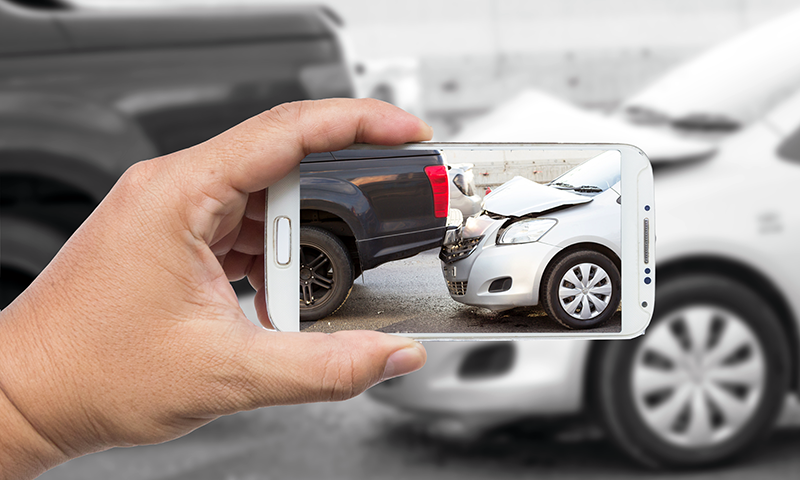By this point in the unfortunate event of an auto accident, you’ve already taken the steps necessary to secure yourself, loved ones, and the vehicle. The next essential step is getting all your documentation in order.
You should always keep important information in your car, like registration, proof of insurance, and the name and phone number of your insurance professional. This way, when you start the process of exchanging information, you have everything you need to offer, and you can prevent yourself from saying anything that could get used against you later.
Insurance Claims
Here is a list of what you should collect for insurance claims:
- Name and contact information
- Insurance company and policy number
- Driver’s license and license plate number
- Type, color, and model of vehicle
- Location of accident
- Be sure to take pictures or video of any damage to both cars, talk to witnesses, write all you can remember about what happened, or even record with audio or video details.
It’s important to contact your insurance company as soon as possible after an accident. Start your auto insurance claim by contacting your insurer directly by phone so you can ask clarifying questions about anything you don’t understand.
Although information is often on an insurer’s website or mobile app, it’s essential you understand what and why you’re entitled to under your policy and state law. Because, after you make a claim with all the provided information your insurer requires, insurance adjusters will determine fault and what you’ll receive to replace your car if it’s totaled or repair its damages.
This is also the time to call the experienced personal injury lawyers at Bart Durham Injury Law.
We will fight for the compensation you deserve!
We will also use each piece of evidence and documentation to help support your claim.
Photos and Videos
Capturing the accident scene in photos is a major component to a successful claim. While this task may appear to be overwhelming, it is essential to the process. To help, we’ve gathered a detailed list for what you need to know about taking pictures after an accident.
REMINDER: Do NOT post photos, videos, or comments of any kind on your social media about the wreck. It's best to stop posting altogether until AFTER you speak with a car accident lawyer. Insurance companies can use your social posts against you and they could affect a potential settlement.
- Make sure your photos capture all four corners of each car.
- Take pictures of the damage and any leaking fluids.
- Take pictures from multiple angles.
- You want to capture all sides of every car involved.
- Give a sense of scale.
- For example, if you’re photographing a dent or scrape, it helps to use an object like a coin or a key to give a sense of scale.
- Take pictures from more than one distance.
- If possible (and safe), stand at least 10 feet away from your car, the other car(s) and/or any other object that you may have collided with (like a street sign).
- Gradually move toward the point of collision, taking more photos as you get closer.
- Take pictures of the surrounding area.
- Take photos of the street.
- If the accident happened at an intersection, it’s a good idea to capture any street signs or traffic signals.
- Take photos of any skid marks or gouge marks left on the pavement or dirt, too.
- Any damage to the car’s interior.
- This might include deployed airbags or shattered glass.
- If you are able, take pictures of your injuries, any scrapes, cuts or bruises.
- This might come in handy if you need to file an injury claim.
- Any other items that will help tell the story.
- For example, photograph any objects in the road that may have contributed to the accident, including potholes, road construction or debris that caused a driver to swerve.
After you photograph the accident scene, take pictures of items that can provide additional and vital details to the situation.
- License plates.
- Get pictures of the license plates of every car involved in the accident.
- If there are any witnesses, it’s a good idea to get a photo of their license plate, which may be useful for the police or your insurance company if the witness leaves the scene early.
- Insurance documents.
- When you exchange insurance information, it’s a good idea to ask to take a photo of the other driver’s insurance card.
- Make sure you capture the company and policy number.
- Police report.
- If the police respond to the scene and write an initial crash report, take a picture of it.
- While your insurance company may need a certified copy of the report that’s filed with your state’s registry of motor vehicles (which can take weeks to receive), a photo of the report may help speed up the claims process.
Be Prepared Before a Wreck
It’s also helpful to consider downloading and setting up your insurer’s mobile app before any collision occurs to expedite the claims process. A good mobile app can be critical because, besides documenting the accident details, your insurer may be able to send a tow truck and provide rental car options via the app.
Depending on your policy, you may have roadside assistance, towing services, rental car coverage or something else to assist you following the moments of an accident.
If applicable, save bills and medical records from the accident since you might need them for claims or court. This is something to discuss in depth with our experienced attorneys. However, they will be there to help with the entire process, every step of the way.



